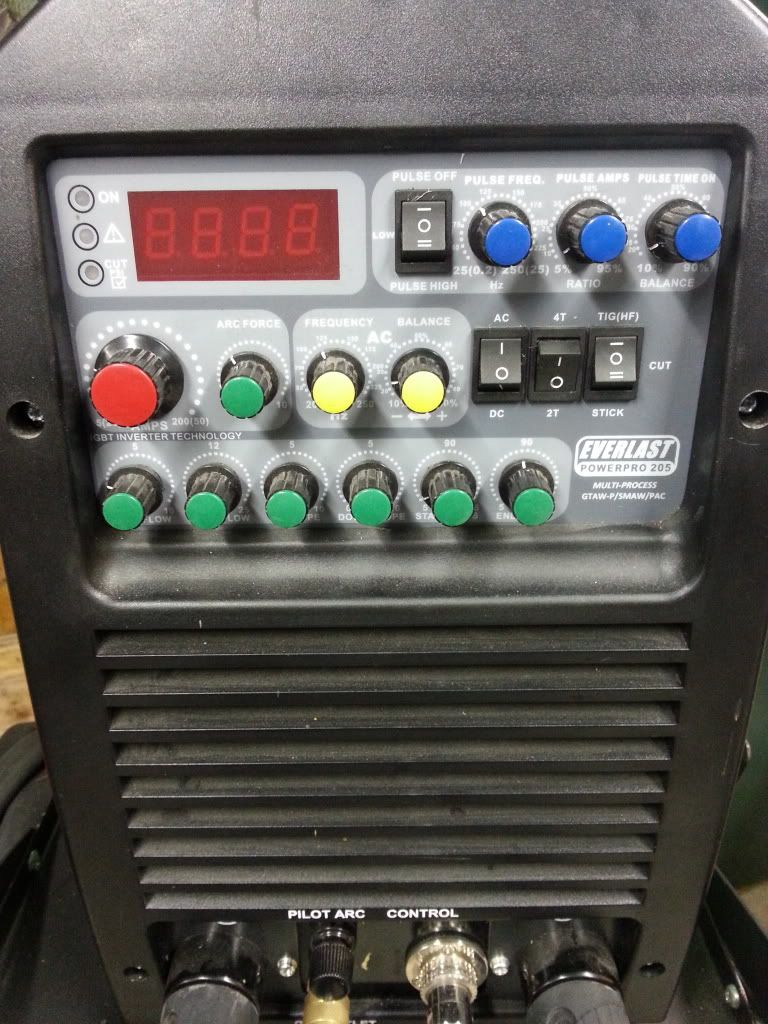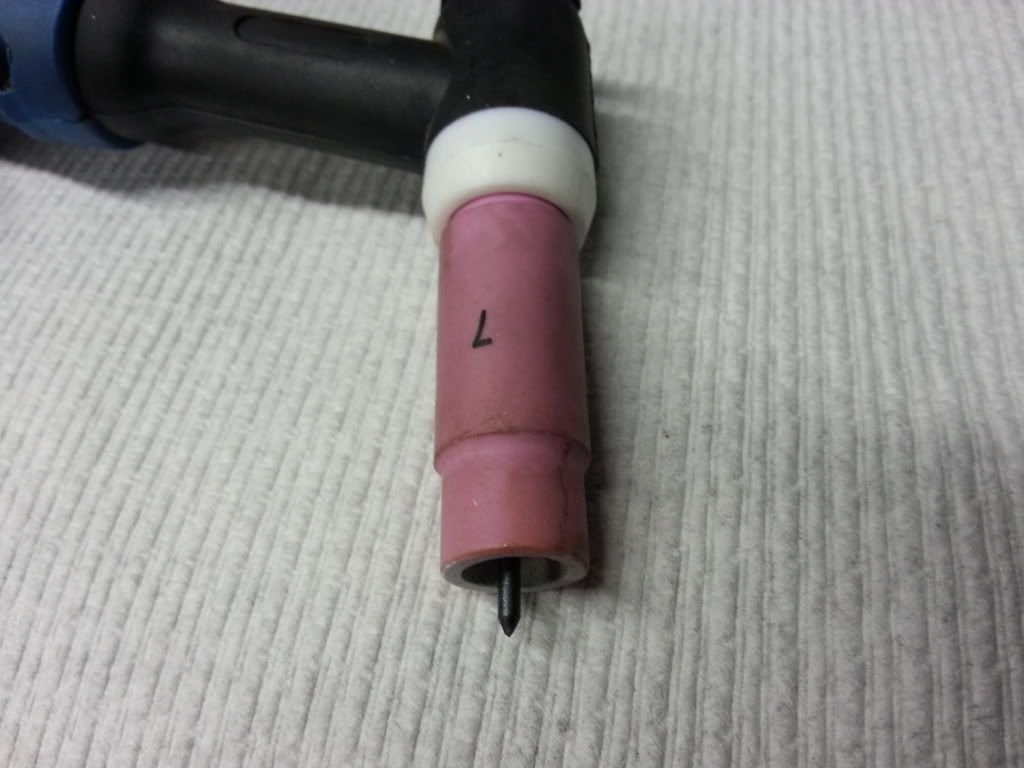Page 1 of 1
Need help with diagnosing problem (pics) SOLVED
Posted: Sat Mar 30, 2013 2:31 pm
by baltor
I'm at wits end, so here I am hoping for help in this forum.
Bought this welder in 2011, and started learning to TIG weld aluminum. I had some success, and was slowly improving. Last year the machine didn't get used for TIG at all. This year I got a replacement bottle of identical gas (ALTIG which is an argon with a small % of helium mix), and was about to weld 2 pieces together when I decided to do a small practice run. Good thing I did! As SOON as the arc started, its instantly contaminated. The aluminum melts and turns black and pitted, and never turns into a shiny pool/puddle like it used to, and the arc jumps wildly all over the place. I've spent hours pouring over everything I could think of. Gas flow rate, AC balance/frequency, amperage, different aluminum pieces from the scrap bin. I've meticulously cleaned them all using a clean stainless brush and/or acetone. The only thing left I can think of is bad or impure gas. Any thoughts?
This is what happens immediately when I start an arc. Its hard to see, but the surrounding area is always covered with a yellow, dusty film almost like sulphur.

As you can see, my AC balance is somewhere around 30%, and frequency is usually between 100-125. I've played with both of these a lot to no avail.

This is what my tip looks like after striking those 2 arcs in the first picture.

Finally, here's the part I want to weld! A new battery holder for my motorcycle.

And advice would be greatly appreciated. I've searched for a long time, and haven't found any satisfactory answers via google.
Thanks
Jon
Re: Need help with diagnosing problem (pics)
Posted: Sat Mar 30, 2013 6:22 pm
by weldin mike 27
Hey,
Welcome to the forum.
The only time I have seen that happen is when you forget to turn the gas on. The electode goes black but usually burns away. So it seems you have some gas but not enough . Could you show a pic of the torch bits taken off, exactly the way they come out? Sometimes a simple mistake in the set up of the torch is to.blame.
Also, just a completely random question, Its a plasma cutter / welder right? Is there ANY way the air for plasma cutting can get into the welding? (I have no idea about these machines)
Mick
Re: Need help with diagnosing problem (pics)
Posted: Sat Mar 30, 2013 6:29 pm
by Otto Nobedder
If that's an air-cooled torch, then you probably either have a new leak in the gas line, or bad gas (it happens more than you might think).
If it's water-cooled, both the above are possible, as well as damage from the wrong coolant/water. For HFAC, you should only use de-ionized or distilled water, and if you need an antifreeze/coolant, you should look for a "low-conductivity" type from a welding supplier. I destroyed two torches (with results like yours) on a rental machine at a contract job before I realized it had automotive antifreeze and (hard) tap water in the cooling system.
I'd first try hunting for line leaks (partially plug the cup so the line is under some pressure, and soap-bubble it from the flowmeter to the torch, including the solenoid inside the machine). Check the o-ring on the back-cap. Also verify good gas flow at the cup, as the collet body can become blocked by repeatedly overtightening the collet and twisting/compressing it. Your gas flow should immediately extinguish a candle at about two inches.
If this is all good, then the coolant (for water cooled) is the next suspect, followed by bad gas. Remember, the only changes from your previous welds are time and a bottle of gas.
Only if all this checks out would I begin to suspect a machine problem, which I find unlikely.
Good luck, and let us know what you finally find; It may help someone else!
Steve S
Re: Need help with diagnosing problem (pics)
Posted: Sun Mar 31, 2013 12:15 pm
by baltor
Thanks for the prompt replies!
Its an air cooled torch. I've checked, and double checked the gas lines, torch assembly (comparing to manual), as well as using different tail caps in case gas was leaking from the back. It blows air well, and I can blow dust around on the floor - so its flowing. I've tried adjusting the flow rate from 5 l/min to upwards of 20 l/min with no discernible difference.
It is a multi process machine, and uses the same "gas" input for both tig and plasma cutting. I made a manifold with ball valves for quick and easy changes back and forth. I will do as you say, and try the soap method to see if there are any leaks.
I did a bit more research, and you're right! Bad gas isn't too uncommon. I found another thread in here last night with almost identical looking pictures -
http://forum.weldingtipsandtricks.com/v ... f=5&t=1469
Looks like I'll be off to my gas supplier tomorrow. I will post the results.
Thanks again,
Jon
Re: Need help with diagnosing problem (pics)
Posted: Sun Mar 31, 2013 2:49 pm
by TamJeff
We went from a liquid argon manifold system to individual bottles once there wasn't enough welders to keep the large system from icing up. In the mean time, the company we dealt with was merged by another and I started getting crappy gas. Some bottles would be 'ok' and some unusable. Seems that someone at the plant was cracking the valves and leaving them open at the plant, and the bottles were getting condensation or something on the inside. Finally had to go to a different company entirely when it wasn't resolved. I would get brown/black arc starts and black tungsten. Some gas would weld sort of OK in the flat position, and fall apart altogether in any other position against gravity. I haven't had much luck with proprietary blended gases and have since opted to use a splitter and blend outside of the bottles. I had at one point suspected companies of padding their argon with CO2 or something at certain times of the month, with shielding being barely enough at certain times with machines using the same, unchanged settings for weeks at a time and only changing performance when bottles were changed out.
First thing I do when I go to set up a gas account is go physically look at the yard and the people working there and how they are handling the bottles and the overall attitude of the place. That may sound picky, or anal, but these ops can cost a guy a lot of money in short order if you happen to be on any kind of schedule from day-to-day. In the event that you end up with a complaint, you will at least likely know where the issue lies, usually with where a company is saving money on the labor end of things.
Re: Need help with diagnosing problem (pics)
Posted: Sun Mar 31, 2013 4:10 pm
by noddybrian
Hi - gas seems to be the obvious issue here - if your sure you have good flow at the cup then contamination seems likely - here in the UK the virtual monopoly company BOC despite all it's faults is actually very good at quality control so I would be looking elsewhere for the problem - maybe where you live suppliers are less reputable ! - BUT as the machine uses the same connection for plasma cutting I would take off your manifold to rule out leaks anyway - but I suspect the problem will be an accumulation of both water & oil from your compressor - it takes the tinniest amount of either in my experience to give you problems - although the multi process machine gives you great versatility with the best will in the world you won't be using " clean " air - to be safe you would need preferably an "oil free" compressor - a refridgerent system to condense the warm water vapour followed by a very very good filter - I doubt this was made clear in the instructions & the cost would be very high - so assume your pipework / manifold / gas solonoid valve & the machines internal pipes & torch connection all need cleaning. At least if I'm right it should be fairly easy to put right - certainly worth a look - if you know anyonw else with a working Tig why not take your gas bottle & try it on their machine - this should tell you if it is the gas or not. Hope this helps.
Re: Need help with diagnosing problem (pics)
Posted: Mon Apr 01, 2013 4:22 pm
by baltor
Well, I don't think anyone here will be very surprised, but IT WAS THE GAS!
I returned the bottle, mentioned that I thought it was contaminated, and they gave me a replacement without batting an eye. I guess I'm not the first person. As soon as I struck an arc I immediately knew that gas had been my problem.
Thanks again guys - you saved me quite a bit of frustration.
Now the only limitation is my lack of welding skills. I can work on that.
Jon
Re: Need help with diagnosing problem (pics)
Posted: Mon Apr 01, 2013 6:33 pm
by Otto Nobedder
Hey, Jon,
Good to hear! That's why I try to rule things out in order of who gets to fix it, i.e. eliminate gas leakage first, then (for water cooled) current leakage, then gas, then the machine... in order of cost to fix (and don't look like a fool if it ain't the gas...

).
Post up some pics of that battery tray when you're done!
Steve S







